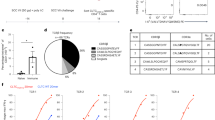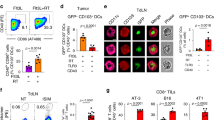Abstract
In an analysis of 84 primary-operated breast cancer patients and 11 healthy donors, we found that the bone marrow of most patients contained memory T cells with specificity for tumor-associated antigens. Patients' bone marrow and peripheral blood contained CD8+ T cells that specifically bound HLA/peptide tetramers. In short-term culture with autologous dendritic cells pre-pulsed with tumor lysates, patients' memory T cells from bone marrow (but not peripheral blood) could be specifically reactivated to interferon-γ–producing and cytotoxic effector cells. A single transfer of restimulated bone-marrow T cells into NOD/SCID mice caused regression of autologous tumor xenotransplants associated with infiltration by human T cells and tumor-cell apoptosis and necrosis. T cells from peripheral blood showed much lower anti-tumor reactivity. Our findings reveal an innate, specific recognition of breast cancer antigens and point to a possible novel cancer therapy using patients' bone-marrow–derived memory T cells.
This is a preview of subscription content, access via your institution
Access options
Subscribe to this journal
Receive 12 print issues and online access
$209.00 per year
only $17.42 per issue
Buy this article
- Purchase on Springer Link
- Instant access to full article PDF
Prices may be subject to local taxes which are calculated during checkout






Similar content being viewed by others
References
Lanzavecchia, A. & Sallusto, F. From synapses to immunological memory: the role of sustained T cell stimulation. Curr. Opin. Immunol. 12, 92–98 (2000).
Goldrath, A.W. & Bevan, M.J. Selecting and maintaining a diverse T-cell repertoire. Nature (Lond.). 402, 255–262 (1999).
Zinkernagel, R.M. et al. On immunological memory. Annu. Rev. Immunol. 14, 333–367 (1996).
Sallusto, F., Lenig, D., Förster, R., Lipp, M. & Lanzavecchia, A. Two subsets of memory T lymphocytes with distinct homing potentials and effector functions. Nature. 402, 708–712 (1999).
Hamann, D. et al. Phenotypic and functional separation of memory and effector human CD8+ T cells. J. Exp. Med. 186, 1407–1418 (1997).
Veiga-Fernandes, H., Walter, U., Bourgeois, C., McLean, A. & Rocha, B. Response of naive and memory CD8+ T cells to antigen stimulation in vivo. Nature Immunol. 1, 47–53 (2000).
Sprent, J., Tough, D.F. & Sun, S. Factors controlling the turnover of T memory cells. Immunol. Rev. 156, 79–85 (1997).
Tanchot, C., Lemonnier, F.A., Perarnau, B., Freitas, A.A. & Rocha, B. Differential requirements for survival and proliferation of CD8 naive or memory T cells. Science 276, 2057–2062 (1997).
Garcia, S., DiSanto, J. & Stockinger, B. Following the development of a CD4 T cell immune response in vivo: from activation to memory formation. Immunity 11, 163–171 (1999).
Khazaie, K. et al. Persistence of dormant tumor cells in the bone marrow of tumor cell-vaccinated mice correlates with long-term immunological protection. Proc. Natl. Acad. Sci. USA 91, 7430–7434 (1994).
Müller, M. et al. Eb-lacZ tumor dormancy in bone marrow and lymph nodes: active control of proliferating tumor cells by CD8+ immune T cells. Cancer Res. 58, 5439–5446 (1998).
Pantel, K., Cote, R.J. & Fodstad, O. Detection and clinical importance of micrometastatic disease. J. Natl. Cancer Inst. 91, 1113–1124 (1999).
Feuerer, M. et al. Enrichment of memory T cells and other profound immunological changes in the bone marrow from untreated breast cancer patients. Int. J. Cancer 92, 96–105 (2001).
Fisk, B., Blevins, T.L., Wharton, J.T. & Ioannides, C.G. Identification of an immunodominant peptide of HER-2/neu protooncogene recognized by ovarian tumor-specific cytotoxic T lymphocyte lines. J. Exp. Med. 181, 2109–2117 (1995).
Brossart, P. et al. Identification of HLA-A2-restricted T-cell epitopes derived from MUC1 tumor antigen for broadly applicable vaccine therapies. Blood 93, 4309–4317 (1999).
Tsomides, T.J. et al. Naturally processed viral peptides recognized by cytotoxic T lymphocytes on cells chronically infected by human immunodeficiency virus type 1. J. Exp. Med. 180, 1283–1293 (1994).
Schultz, L.D. et al. Multiple defects in innate and adaptive immunologic function in NOD/LtSz-scid mice. J. Immunol. 154, 180–191 (1995).
Visonneau, S. Cesano, A., Torosian, M.H., Miller, E.J. & Santoli, D. Growth characteristics and metastatic properties of human breast cancer xenografts in immunodeficient mice. Am. J. Pathol. 152, 1299–1311 (1998).
Slavin, S. et al. Allogeneic cell therapy with donor peripheral blood cells and recombinant human interleukin-2 to treat leukemia relapse post allogeneic bone marrow transplantation. Blood 87, 2195–2204 (1996).
Rosenberg, S.A. et al. Prospective randomized trial of high-dose interleukin-2 alone or in conjuction with lymphokine-activated killer cells for the treatment of patients with advanced cancer. J. Natl. Cancer Inst. 85, 622–632 (1993).
Rosenberg, S.A. A new era for cancer immunotherapy based on the genes that encode cancer antigens. Immunity 10, 281–287 (1999).
Schirrmacher, V., Schild, H.J., Gückel, B. & von Hoegen, P. Tumor specific CTL response requiring interactions of four different cell types and dual recognition of MHC class I and class II restricted tumor antigens. Immunol. Cell Biol. 71, 311–326 (1992).
Singh-Jasuja, H. et al. The heat shock protein gp96 induces maturation of dendritic cells and down-regulation of ist receptor. Eur. J. Immunol. 30, 2211–2215 (2000).
Sauter, B. et al. Consequences of cell death: Exposure to necrotic tumor cells, but not primary tissue cells or apoptotic cells, induces the maturation of immunostimulatory dendritic cells. J. Exp. Med. 191, 423–433 (2000).
Gilboa, E. The making of a tumor rejection antigen. Immunity 11, 263–270 (1999).
Finn, O.J. et al. MUC1 epithelial tumor-mucin-based immunity and cancer vaccines. Immunol.Rev. 145, 61–89 (1995).
Disis, M.L., Grabstein, K.H., Sleath, D.R. & Cheever, M.A. Generation of immunity to the HER-2/neu oncogenic protein in patients with breast and ovarian cancer using a peptide–based vaccine. Clin. Cancer Res. 5, 1289–1297 (1999).
Fields, R.C., Shimizu, K. & Mule, J.J. Murine dendritic cells pulsed with whole tumor lysates mediate potent antitumor immune responses in vitro and in vivo. Proc. Natl. Acad. Sci. USA 96, 8639–8644 (1999).
Müerköster, S. et al. Graft-versus-Leukemia reactivity involves cluster formation between superantigen-reactive donor T lymphocytes and host macrophages. Clin. Cancer Res. 4, 3095–3106 (1998).
Lee, P.D. et al. Charcterization of circulating T cells specific for tumor-associated antigens in melanoma patients. Nature Med. 5, 677–685 (1999).
Valmori, D. et al. Naturally occuring human lymphocyte antigen-A2 restricted CD8+ T-cell response to the cancer testis antigen NY-ESO-1 in melanoma patients. Cancer Res. 60, 4499–4506 (2000).
Paramithiotis, E. & Cooper, M.D. Memory B lymphocytes migrate to bone marrow in humans. Proc. Natl. Acad. Sci. USA 94, 208–212 (1997).
Slifka, M.K., Whitmire, J.K. & Ahmed, R. Bone marrow contains virus-specific cytotoxic T lymphocytes. Blood 90, 2103–2108 (1997).
Price, P.W. & Cerny, J. Characterization of CD4+ T cells in mouse bone marrow. I. Increased activated/memory phenotype and altered TCR V-β repertoire. Eur. J. Immunol. 29, 1051–1056 (1999).
Kuroda, M.J. et al. Simian immunodeficiency virus-specific cytotoxic T lymphocytes and cell-associated viral RNA levels in distinct lymphoid compartments of SIVmac-infected rhesus monkeys. Blood 96, 1474–1479 (2000).
Papayannopoulou, T., Craddock, C., Nakamoto, B., Priestley, G.V. & Wolf, N.S. The VLA4/VCAM-1 adhesion pathway defines contrasting mechanisms of lodgement of transplanted murine hemopoietic progenitors between bone marrow and spleen. Proc. Natl. Acad. Sci. USA 92, 9647–9651 (1997).
Briskin, M.J. et al. Human mucosal addressin cell adhesion molecule-1 is preferentially expressed in intestinal tract and associated lymphoid tissue. Am. J. Pathol. 151, 97–110 (1997).
Berlin, C. et al. α4β7 integrin mediates lymphocyte binding to the mucosal vascular addressin MAdCAM-1. Cell 74, 185–195 (1993).
Erle, D.J. et al. Expression and function of the MAdCAM-1 receptor, integrin α4β7, on human leucocytes. J. Immunol. 153, 517–528.
Nestle, F.O. et al. Vaccination of melanoma patients with peptide- or tumor lysate-pulsed dendritic cells. Nature Med. 4, 328–332 (1998).
Kugler, A. et al. Regression of human metastatic renal cell carcinoma after vaccination with tumor cell-dendritic cell hybrids. Nature Med. 6, 332–336 (2000).
Diel, K.J. et al. Micrometastatic breast cancer cells in bone marrow at primary surgery - prognostic value in comparison to nodal status. J. Natl. Cancer Inst. 88, 1652–1658 (1996).
Schuler, G. et al. in Dendritic cells (eds. Lotze, M.T. & Thomson, A.W.) 515–534 (Academic Press, San Diego, California, 1999).
Lalvani, A. et al. Rapid effector function in CD8+ memory T cells. J. Exp. Med. 186, 859–865 (1997).
Brossart, P. & Bevan, M.J. Selective activation of Fas/FasL mediated cytotoxicity by a self-peptide. J. Exp. Med. 183, 2449–2458 (1996).
Acknowledgements
This article is based on a PhD study by Markus Feuerer, University Heidelberg. We thank M. Rocha for initial help with establishing the clinical contact and the ELISPOT assay; J. Heep for providing some clinical samples; B. Kyewski for comments on the manuscript; G. Moldenhauer for human and mouse immunoglobulins and antibodies against HLA class I and HLA class II; S. Kaul for mAbs to human MUC1; A. Benner for help with statistics; J. Foerster, M. Bucur and M. Gehring for excellent technical assistance. We thank the NIAID Tetramer Facility and NIH AIDS Research and Reference Reagent Program (Bethesda, MD) for providing HLA-A2/peptide tetrameric complexes and the D. Hopp-Stiftung (Walldorf) and the M. Scheel-Stiftung (no. 10-1589-Schi5) for financial support.
Author information
Authors and Affiliations
Corresponding author
Rights and permissions
About this article
Cite this article
Feuerer, M., Beckhove, P., Bai, L. et al. Therapy of human tumors in NOD/SCID mice with patient-derived reactivated memory T cells from bone marrow. Nat Med 7, 452–458 (2001). https://doi.org/10.1038/86523
Received:
Accepted:
Issue Date:
DOI: https://doi.org/10.1038/86523
This article is cited by
-
Common clonal origin of conventional T cells and induced regulatory T cells in breast cancer patients
Nature Communications (2021)
-
Bone marrow T helper cells with a Th1 phenotype induce activation and proliferation of leukemic cells in precursor B acute lymphoblastic leukemia patients
Oncogene (2019)
-
NKILA lncRNA promotes tumor immune evasion by sensitizing T cells to activation-induced cell death
Nature Immunology (2018)
-
Humanized Mouse Models for the Preclinical Assessment of Cancer Immunotherapy
BioDrugs (2018)
-
Pediatric precursor B acute lymphoblastic leukemia: are T helper cells the missing link in the infectious etiology theory?
Molecular and Cellular Pediatrics (2017)



